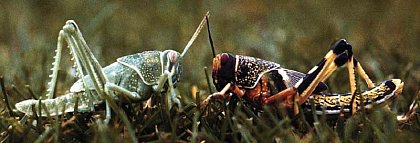PD Dr. Silvio Erler

Dr. Erler has left our group in 2019.
Research Interests
- Host-parasite evolution
- Biology of social insect diseases
- Ageing and immunity of social insects (Apis, Bombus)
- Evolution of insect innate immune system and behavioural immunity
- Genetic basis of caste determination
- Evolution of mitochondrial genomes (social insects, Orthoptera)
- Genome annotation, immunity genes (Bombus)
Curriculum vitae
Academic Education
- 2018: Habilitation, PD Dr. habil., (MLU Halle-W.)
Thesis: Evolution of innate and social immunity in eusocial bees - 2012: Dissertation, Dr. rer. nat.: MLU Halle-W.
Thesis: Molecular Analysis of Host-Parasite Interaction in the Bumblebee Bombus terrestris (Linnaeus, 1758) - 2008: Diploma (Biology): MLU Halle-W.
Professional Career
- Since 10/2018: Deputy head of chair of 'Animal Ecology', Martin-Luther-University Halle-W.
- 2013-2018: Lecturer / Research associate, MLU Halle-W., Molecular Ecology group
- 2012-2013: Postdoctoral researcher, University of Agricultural Sciences and Veterinary Medicine Cluj-Napoca (Romania), employed in ERDF project RoBeeTech
- 2008-2011: PhD student, research assistant, MLU Halle-W.
- 2003-2008: Student of Biology at the Martin-Luther-University Halle-Wittenberg
Referee Activities
- African Entomology; AGE; Agriculture, Ecosystems & Environment; Annales de la Société Entomologique de France; Animal Behaviour; Apidologie; Biological Journal of the Linnean Society; Bulletin of Insectology; European Journal of Entomology; Evolution; Evolutionary Ecology; Experimental Gerontology; Frontiers in Microbiology; Industrial Crops and Products; Insects; Journal of Apicultural Research; Journal of Asia-Pacific Entomology; Journal of Economic Entomology; Journal of Evolutionary Biology; Journal of Insect Science; Journal of Invertebrate Pathology; Microbiome; Parasitology Research; PeerJ; Pharmaceutical Biology; PLoS ONE; PLoS Pathogens; Proceedings of the Royal Society B; Regulatory Peptides; Royal Society Open Science; Scientific Reports; The Science of Nature (Naturwissenschaften); Virulence; Zoological Studies
- BBSRC (Biotechnology and Biological Sciences Research Council, part of Research Councils UK), NRF (National Research Foundation, South Africa), NSF (National Science Foundation, USA)
Funding
- 2015-2019: "Self-medication and innate immunity in the honeybee Apis mellifera", German Research Foundation (DFG)
Publications
Peer-reviewed
- Lewkowski O, Erler S (2019): Virulence of Melissococcus plutonius and secondary invaders associated with European foulbrood disease of the honey bee. MicrobiologyOpen 8(3), e649
- Ehrenberg S, Lewkowski O, Erler S (2019): Dyeing but not dying: colourful dyes as a non-lethal method of food labelling for in vitro-reared honey bee (Apis mellifera) larvae. Journal of Insect Physiology 113: 1-8
- von Büren RS, Oehen B, Kuhn NJ, Erler S (2019): High-resolution maps of Swiss apiaries and their applicability to study spatial distribution of bacterial honey bee brood diseases. PeerJ 7: e639
- Viljakainen L, Jurvansuu J, Holmberg I, Pamminger T, Erler S, Cremer S (2018): Social environment affects the transcriptomic response to bacteria in ant queens. Ecology and Evolution 8(22): 11031-11070.
- Wiese N, Fischer J, Heidler J, Lewkowski O, Degenhardt J, Erler S (2018): The terpenes of leaves, pollen, and nectar of thyme (Thymus vulgaris) inhibit growth of bee disease-associated microbes. Scientific Reports 8: 14634
- Djukic M, Erler S, Leimbach A, Grossar D, Charrière J-D, Gauthier L, Hartken D, Dietrich S, Nacke H, Daniel R, Poehlein A (2018): Comparative genomics and description of putative virulence factors of Melissococcus plutonius, the causative agent of European foulbrood disease in honey bees. Genes 9 (8): 419
- Sann C, Wemheuer F, Beaurepaire A, Daniel R, Erler S, Vidal S (2018): Preliminary investigation of species diversity of rice hopper parasitoids in Southeast Asia. Insects 9(1): 19
- Erler S, Lewkowski O, Poehlein A, Forsgren A (2018): The curious case of Achromobacter eurydice, a Gram-variable pleomorphic bacterium associated with European foulbrood disease in honeybees. Microb Ecol 75(1): 1-6.
- Dezmirean DS, Mărghitaş LA, Chirilă F, Copaciu F, Simonca V, Bobiş O, Erler S (2017): Influence of geographic origin, plant source and polyphenolic substances on antimicrobial properties of propolis against human and honey bee pathogens. J Apiclut Res 56(5): 588-597
- Pieplow JT, Brauße J, van Praagh JP, Moritz RFA, Erler S (2017): A scientific note on using large mixed sperm samples in instrumental insemination of honeybee queens. Apidologie 48(5): 716-718)
- Tautenhahn H-M, Brückner S, Uder C, Erler S, Hempel M, von Bergen M, Brach J, Winkler S, Pankow F, Gittel C, Baunack M, Lange U, Broschewitz J, Dollinger M, Bartels M, Pietsch U, Amann K, Christ B (2017): Mesenchymal stem cells correct haemodynamic dysfunction associated with liver injury after extended resection in a pig model. Sci Rep 7: 2617
- Lattorff HMG, Popp M, Parsche S, Helbing S, Erler S (2016): Effective population size as a driver for divergence of an antimicrobial peptide (Hymenoptaecin) in two common European bumblebee species. Biol J Linn Soc 119(2): 299-310
- Aurori AC, Bobiş O, Dezmirean DS, Mărghitaş LA, Erler S (2016): Bay laurel (Laurus nobilis) as potential antiviral treatment in naturally BQCV infected honeybees. Virus Res 222: 29-33
- Mărgăoan R, Zăhan M, Mărghitaş LA, Dezmirean DS, Erler S, Bobiş O (2016): Antiproliferative activity and apoptotic effects of Filipendula ulmaria pollen against C26 mice colon tumour cells. J Apic Sci 60(1): 135-144
- Erler S, Moritz RFA (2016): Pharmacophagy and pharmacophory: mechanisms of self-medication and disease prevention in the honeybee colony (Apis mellifera). Apidologie 47(3): 389-411
- Moritz RFA, Erler S (2016): Lost colonies found in a data mine: Global honey trade but not pests or pesticides as a major cause of regional honeybee colony declines. Agric Ecosyst Environ 216: 44-50.
- Kurze C, Le Conte Y, Dussaubat C, Erler S, Kryger P, Lewkowski O, Müller T, Widder M, Moritz RFA (2015): Nosema tolerant honeybees (Apis mellifera) escape parasitic manipulation of apoptosis. PLoS ONE 10(10): e0140174.
- Aurori A, Erler S, Bobis O, Dezmirean DS, Mărghitaş LA (2015): Screening for antivirals using an in vivo honeybee - BQCV model system. J Biotechnol 208 (Supplement): S27-S28.
- Barribeau SM, Sadd BM, du Plessis L, Brown MJF, Buechel SD, Cappelle K, Carolan JC, Christiaens O, Colgan TJ, Erler S, Evans J, Helbing S, Karaus E, Lattorff HMG, Marxer M, Meeus I, Näpflin K, Niu J, Schmid-Hempel R, Smagghe G, Waterhouse RM, Yu N, Zdobnov EM, Schmid-Hempel P (2015): A depauperate immune repertoire precedes evolution of sociality in bees. Genome Biol 16: 83.
- Sadd BM, Barribeau SM, Bloch G, de Graaf DC, Dearden P, Elsik CG, Gadau J, Grimmelikhuijzen CJP, Hasselmann M, Lozier JD, Robertson HM, Smagghe G, Stolle E, Van Vaerenbergh M, Waterhouse RM, Bornberg-Bauer E, Klasberg S, Bennett AK, Câmara F, Guigó R, Hoff K, Mariotti M, Munoz-Torres M, Murphy T, Santesmasses D, Amdam GV, Beckers M, Beye M, Biewer M, Bitondi MMG, Blaxter ML, Bourke AFG, Brown MJF, Buechel SD, Cameron R, Cappelle K, Carolan JC, Christiaens O, Ciborowski KL, Clarke DF, Colgan TJ, Collins DH, Cridge AG, Dalmay T, Dreier S, du Plessis L, Duncan E, Erler S, Evans J, Falcon T, Flores K, Freitas FCP, Fuchikawa T, Gempe T, Hartfelder K, Hauser F, Helbing S, Humann FC, Irvine F, Jermiin LS, Johnson CE, Johnson RM, Jones AK, Kadowaki T, Kidner JH, Koch V, Köhler A, Kraus FB, Lattorff HMG, Leask M, Lockett GA, Mallon EB, Marco Antonio DS, Marxer M, Meeus I, Moritz RFA, Nair A, Näpflin K, Nissen I, Niu J, Nunes FMF, Oakeshott JG, Osborne A, Otte M, Pinheiro DG, Rossié N, Rueppell O, Santos CG, Schmid-Hempel R, Schmitt BD, Schulte C, Simões ZLP, Soares MPM, Swevers L, Winnebeck EC, Wolschin F, Yu N, Zdobnov EM, Aqrawi PK, Blankenburg KP, Coyle M, Francisco L, Hernandez AG, Holder M, Hudson ME, Jackson LR, Jayaseelan J, Joshi V, Kovar C, Lee SL, Mata R, Mathew T, Newsham IF, Ngo R, Okwuonu G, Pham C, Pu L-L, Saada N, Santibanez J, Simmons DN, Thornton R, Venkat A, Walden KKO, Wu Y-Q, Debyser G, Devreese B, Asher C, Blommaert J, Chipman AD, Chittka L, Fouks B, Liu J, O'Neill MP, Sumner S, Puiu D, Qu J, Salzberg SL, Scherer SE, Muzny DM, Richards S, Robinson GE, Gibbs RA, Schmid-Hempel P, Worley KC (2015): The genomes of two key bumblebee species with primitive eusocial organization. Genome Biol 16: 76.
- Furdui EM, Mărghitaş LA, Dezmirean DS, Paşca I, Pop IF, Erler S, Schlüns EA (2014): Genetic characterization of Bombyx mori (Lepidoptera: Bombycidae) breeding and hybrid lines with different geographic origins. J Insect Sci 14: 211.
- Gherman BI, Denner A, Bobiş O, Dezmirean DS, Mărghitaş LA, Schlüns H, Moritz RFA, Erler S (2014): Pathogen-associated self-medication behavior in the honeybee Apis mellifera. Behav Ecol Sociobiol 68(11): 1777-1784.
- Erler S, Denner A, Bobiş O, Forsgren E, Moritz RFA (2014): Diversity of honey stores and their impact on pathogenic bacteria of the honeybee, Apis mellifera. Ecol Evol 4(20): 3960-3967.
- Aurori CM, Buttstedt A, Dezmirean DS, Mărghitaş LA, Moritz RFA, Erler S (2014): What is the main driver of ageing in long-lived winter honey bees – antioxidant enzymes, innate immunity or vitellogenin? J Gerontol A-Biol 69(6): 633-639.
- Coroian CO, Muñoz I, Schlüns EA, Paniti-Teleky OR, Erler S, Furdui EM, Mărghitaş LA, Dezmirean DS, Schlüns H, De la Rúa P and Moritz RFA (2014): Climate rather than geography separates two European honeybee subspecies. Mol Ecol 23(9): 2353-2361.
- Buttstedt A, Moritz RFA, Erler S (2014): Origin and function of the major royal jelly proteins of the honeybee (Apis mellifera) as members of the yellow gene family. Biol Rev 89(2): 255-269.
- Erler S, Lhomme P, Rasmont P, Lattorff HMG (2014): Rapid evolution of antimicrobial peptide genes in an insect host-social parasite system. Infect Genet Evol 23: 129-137.
- Buttstedt A, Moritz RFA, Erler S (2013): More than royal food - Major royal jelly protein genes in sexuals and workers of the honeybee Apis mellifera. Front Zool 10: 72.
- Coroian A, Erler S, Matea CT, Mireșan V, Răducu C, Bele C, Coroian CO (2013): Seasonal changes of buffalo colostrum: physicochemical parameters, fatty acids and cholesterol variation. Chem Cent J 7: 40.
- Popp M, Erler S, Lattorff HMG (2012): Seasonal variability of prevalence and occurrence of multiple infections shape the population structure of Crithidia bombi, an intestinal parasite of bumblebees (Bombus spp.). MicrobiologyOpen 1(4): 362-372
- Dezmirean GI, Bobiş O, Bonta V, Dezmirean DS, Mărghitaş LA, Erler S (2012): Botanical origin cause changes in the nutritional profile and antioxidant activity of fermented products obtained from honey. J Agr Food Chem 60(32): 8028-8035.
- Erler S, Popp M, Wolf S, Lattorff HMG (2012): Sex, horizontal transmission and multiple hosts prevent local adaptation of Crithidia bombi, a parasite of bumblebees (Bombus spp.). Ecol Evol 2(5): 930-940.
- Richter J, Helbing S, Erler S, Lattorff HMG (2012): Social context-dependent immune gene expression in bumblebees (Bombus terrestris). Behav Ecol Sociobiol 66(5): 791-796.
- Erler S, Lommatzsch S, Lattorff HMG (2012): Comparative analysis of detection limits and specificity of molecular diagnostic markers for three pathogens (Microsporidia, Nosema spp.) in the key pollinators Apis mellifera and Bombus terrestris. Parasitol Res 110(4): 1403-1410
- von Einem S, Erler S, Bigl K, Frerich B, Schwarz E (2011): The pro-form of BMP-2 exhibits a delayed and reduced activity when compared to mature BMP-2. Growth Factors 29(2-3): 63-71
- Erler S, Popp M, Lattorff HMG (2011): Dynamics of immune system gene expression upon bacterial challenge and wounding in a social insect (Bombus terrestris). PLoS ONE 6(3): e18126
- Erler S, Lattorff HMG (2010): The degree of parasitism of the bumblebee (Bombus terrestris) by cuckoo bumblebees (Bombus (Psithyrus) vestalis). Insect Soc 57(4): 371-377
- Erler S, Ferenz H-J, Moritz RFA, Kaatz H-H (2010): Analysis of the mitochondrial genome of Schistocerca gregaria gregaria (Orthoptera: Acrididae). Biol J Linn Soc 99(2): 296-305
Book reviews
- Erler S (2012): SCHMID-HEMPEL, P. 2011: Evolutionary parasitology: the integrated study of infections, immunology, ecology, and genetics. Myrmecol News 17: 32
Non Peer-reviewed
- Erler S, (2014): Selbstbehandlung bei Bienen. Deutsches Bienen-Journal 22(10): 31.
- Popp M, Erler S, Lattorff HMG (2009): FUGABEE: Funktionelle Analyse von Krankheitsresistenzgenen bei der Erdhummel (Bombus terrestris). Genomxpress 4.09: 7-10





